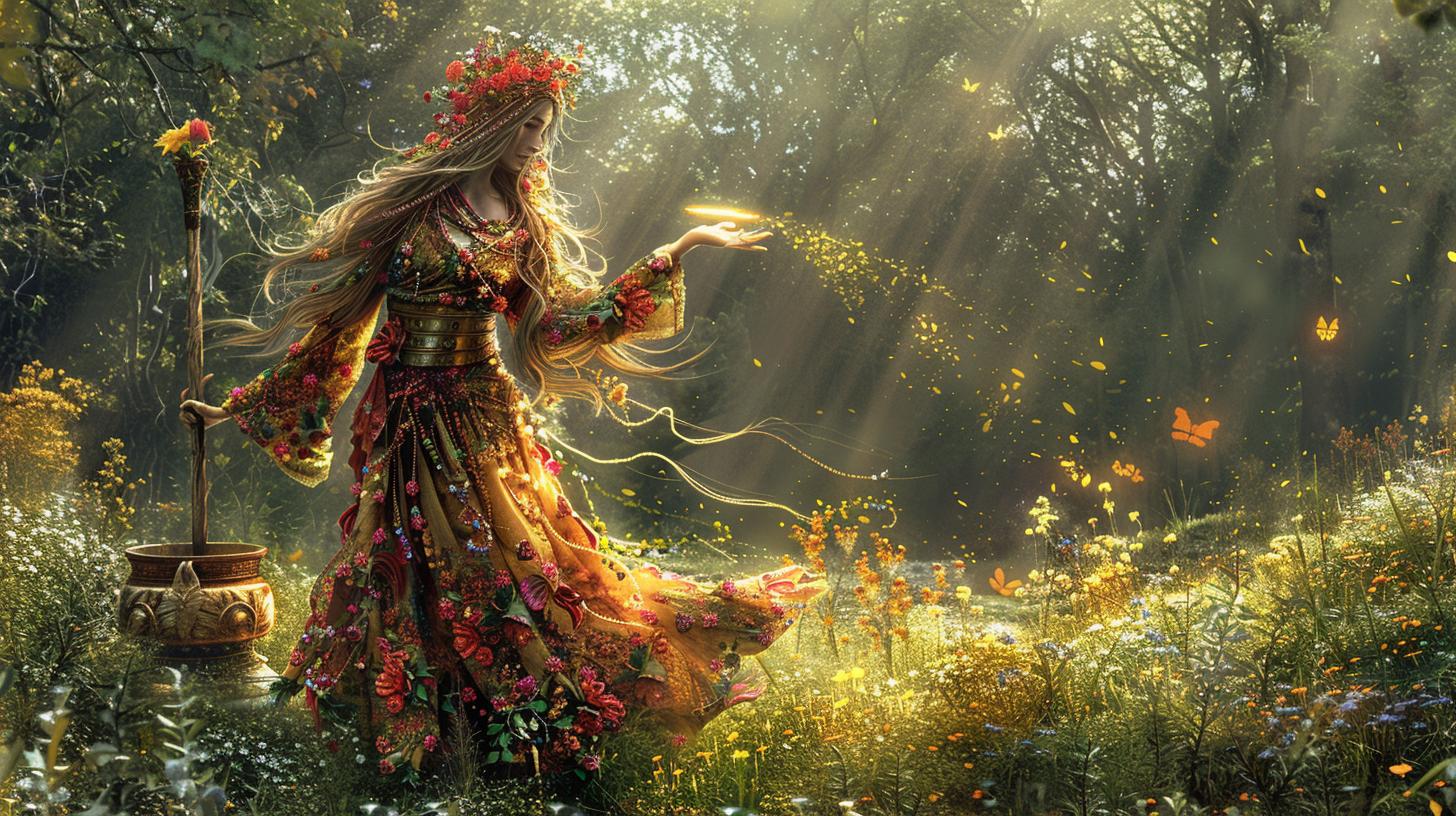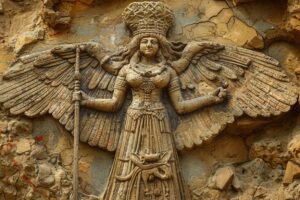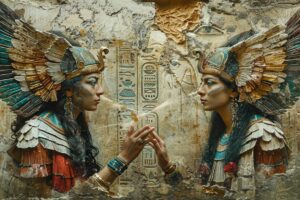Kamrusepa Goddess: Healing, Magic, and Mythology Explained

Kamrusepa is a goddess in Hittite and Luwian mythology associated with healing and magic. She plays a crucial role in myths like the Telepinu Myth, where she helps restore balance and fertility.
Her domain includes medicine, magic, and midwifery. Kamrusepa’s worship dates back to ancient texts from Kanesh and extends through various regions, highlighting her long-standing significance in ancient belief systems.
Significance in Hittite and Luwian Mythology
Kamrusepa holds a pivotal place in ancient mythology, frequently intersecting with other significant deities and myths.
Connections with Hattic and Palaic Deities
Kamrusepa’s connections extend beyond Hittite and Luwian mythologies. She is linked with the Hattic and Palaic goddess Kataḫzipuri, showcasing the fluidity of divine roles across different cultures.
In Hattic mythology, Kamrusepa shares characteristics with Kataḫzipuri, whose name translates to “queen of the land.”
This connection underscores their shared attributes of healing and magic. Both deities are revered for their roles in maintaining cosmic balance and harmony.
Relationship to the Telepinu Myth
Kamrusepa’s involvement in the Telepinu Myth is central to understanding her significance. The Telepinu Myth narrates the disappearance of the vegetation god Telipinu, whose absence caused widespread calamity on earth.
- Kamrusepa’s role involves performing a crucial ritual to pacify Telipinu’s rage.
- She orchestrates a magical procedure that includes offering twelve sheep from the herds of the sun god.
- The ritual is essential for Telipinu’s return, restoring fertility and balance to the world.
This myth highlights Kamrusepa’s importance in ancient rituals, reinforcing her status as a deity who restores order and harmony.
Impact on Ancient Belief Systems
Kamrusepa significantly influenced ancient belief systems. Her domains of healing and magic were vital in ancient societies, intertwining with everyday life through rituals and medical practices.
- Many medical procedures attributed to Kamrusepa were documented in ritual texts and passed down through generations.
- Her mythological narratives emphasize the importance of divine intervention in human affairs, particularly in restoring health and equilibrium.
Kamrusepa’s influence extended to various other deities, reinforcing the interconnectedness of ancient mythologies.
Her role as a divine figure who could communicate with humans through dreams and visions underscored her compassionate nature as a healer.
Role and Attributes
Kamrusepa is a Hittite and Luwian goddess known for her significant roles in healing, medicine, and magic.
Healing and Medicine
Contributions to Medical Procedures
Kamrusepa is credited with inventing many medical procedures that were later shared with humanity. Her knowledge in medicine included the use of herbs and natural remedies. These innovations were crucial in the development of ancient medical practices.
Ritual Texts and Innovations
Numerous ritual texts mention Kamrusepa’s contributions to healing, highlighting her as a divine figure responsible for the creation of various healing rituals. These texts provide mythical explanations of her medical practices and their implementations.
Magic and Rituals
Rituals for Dispelling Malevolent Spirits
Kamrusepa’s magic extended to rituals designed to protect individuals from malevolent spirits and supernatural harm. She used incantations and spells that were believed to purify and safeguard the afflicted.
Communication Through Dreams and Visions
Another aspect of Kamrusepa’s magical abilities was her power to communicate with humans through dreams and visions.
This form of divine communication offered guidance and comfort, establishing her as a compassionate and approachable deity.
Familial and Divine Relationships
Kamrusepa holds a significant place in the familial and divine hierarchy, connecting her to other prominent deities.
Connection to Tiwad and Sun Goddess Arinnanda
Kamrusepa is intricately linked with Tiwad, the sun god in Luwian mythology. Their connection emphasizes her celestial significance and her role within the divine realm. Additionally, Kamrusepa collaborates with the Sun Goddess Arinnanda.
This partnership signifies a union between light and healing, showcasing a harmonized force in the celestial domain.
Protector and Mother of Deities
Relationship with the Weather God Tarhunna
Kamrusepa’s relationship with Tarhunna, the weather god, further cements her position in the mythological hierarchy. She aids Tarhunna in his battles against malevolent forces, utilizing her profound knowledge of magic and healing.
This relationship underscores her supportive and nurturing roles within the pantheon.
Maternal Role in Mythology
Kamrusepa is often depicted as a motherly figure to various deities. One notable aspect is her role as the mother of Aruna, reflecting her contribution to the divine lineage. She also acts as a protective deity for Tauriša, ensuring the safety and sanctity of the city’s tutelary deity.
Her maternal qualities are central to her identity, portraying her as a nurturing and safeguarding presence in mythology.
Her associations with other gods highlight the multifaceted nature of her divinity, extending her influence across various realms and aspects of life.
Worship and Rituals
The worship of Kamrusepa extends back to ancient times, with her rituals and ceremonies reflecting her profound significance in Hittite and Luwian cultures.
Early Worship History
Textual Evidence from Kanesh
The earliest records of Kamrusepa’s worship come from Kanesh, indicating a long-standing veneration. Texts from this period highlight her importance in rituals involving magic and healing. These ancient documents reveal that Kamrusepa was invoked in various ceremonies aimed at ensuring community well-being.
Influence in Kizzuwatna
In Kizzuwatna, Kamrusepa held a prominent position in religious practices. Ritual texts from this region often include invocations to her, particularly in rites designed to dispel malevolent forces and promote healing.
Her influence in Kizzuwatna underscores her integral role in the local pantheon and societal rituals.
Cultural Integration
Roles in Luwian and Hittite Festivals
Kamrusepa was celebrated in numerous festivals, both in Luwian and Hittite cultures. During these festivals, she was honored through various ceremonies that highlighted her attributes as a healer and magician.
Such festivals not only paid homage to Kamrusepa but also served to reinforce communal bonds and cultural identity.
Decline in Worship Post-Bronze Age
The worship of Kamrusepa saw a decline after the Bronze Age. This reduction in veneration may be attributed to changes in religious practices and societal structures. Despite the decline, her legacy continued to influence later cultural and spiritual traditions, albeit in a more subdued manner.
Mythological Significance: The Telepinu Myth
Kamrusepa plays a crucial role in the Telepinu Myth, which revolves around the disappearance and eventual return of the vegetation god, Telipinu.
The Missing Vegetation God
The myth begins with the sudden disappearance of Telipinu, the god associated with vegetation and fertility. His absence causes chaos in the natural world, leading to famines, droughts, and widespread suffering among both humans and animals.
The gods, realizing the dire consequences of Telipinu’s absence, become desperate to restore balance and fertility to the earth.
Without Telipinu, plants wither, animals fail to reproduce, and the land loses its vitality.
The other deities search for Telipinu but are unable to locate him. His absence symbolizes a disruption in the natural order, highlighting the interconnectedness of gods and the vitality of the earth in ancient belief systems.
Kamrusepa’s Ritualistic Procedures
Kamrusepa, being a goddess of healing and magic, is called upon to find a solution. Her role is pivotal in performing rituals that aim to pacify Telipinu’s rage and bring him back.
Kamrusepa’s methods involve intricate magical procedures and offerings.
Offering to the Sun God
One crucial aspect of Kamrusepa’s ritual is the offering to the sun god. She selects twelve sheep from the herds of the sun god and prepares them as part of the ceremony.
This act is symbolic, representing a plea to the higher celestial powers for intervention. The sheep are meant to appease the sun god and ensure his cooperation in the ritual.
The offering signifies the exchange between the earthly and divine realms, seeking divine approval and support to restore cosmic order.
Kamrusepa’s role in coordinating these offerings underscores her importance in the pantheon as a mediator between gods and humans.
Role of Ḫapantali
An additional key player in the ritual is Ḫapantali, a Luwian shepherd goddess. Kamrusepa collaborates with Ḫapantali, entrusting her with the sheep offering. Ḫapantali’s involvement emphasizes the communal effort among various deities to resolve the crisis caused by Telipinu’s disappearance.
Ḫapantali’s role as a shepherd goddess signifies the protection and nurturing aspects necessary to bring Telipinu back. Her presence in the ritual highlights the interconnectedness of deities in ancient mythological narratives, where cooperation among gods is essential for restoring balance.
The cooperative effort of Kamrusepa and Ḫapantali demonstrates the complexity and depth of ancient ritualistic practices, emphasizing the reliance on both magical and inter-deity relationships to solve cosmic issues.
Symbolism and Representation
Kamrusepa’s symbolism in Hittite and Luwian mythology is rich, reflecting her multifaceted roles in magic and healing.
Symbolic Artifacts and Imagery
The Iron Throne
Kamrusepa is often symbolized by an iron throne. This artifact signifies her authority and divine status in the pantheon. The iron throne serves as a powerful icon of her strength and leadership among the deities.
Chariot Drawn by Horses
Another significant image is her chariot, pulled by horses. This mode of transportation underscores her celestial nature, linking her to the heavens. It suggests her ability to traverse vast dimensions and influence both earthly and divine realms.
Associations with Natural Elements
Connection to Clouds and Smoke
Kamrusepa has deep connections with natural elements such as clouds and smoke. These associations likely stem from linguistic interpretations of her name, implying a presence that is both ethereal and omnipresent.
Clouds and smoke are elements that symbolize her intangible yet pervasive influence.
Implications for Purification
Her connection to these elements also extends to themes of purification. As smoke rises and dissipates impurities, Kamrusepa’s rituals and practices similarly aim to cleanse and heal. This symbolism ties her to the natural cycles of renewal and purification, fundamental to her role in healing practices.
Names and Etymology
The goddess associated with healing and magic in Hittite and Luwian mythology is known by various names across different cultures, each with unique etymological roots and meanings.
Variations Across Cultures
Kamriwasepa and Suliskanu
Kamrusepa is known as Kamriwasepa in Luwian culture and Suliskanu in Hurrian territories.
These names highlight her role and attributes in different regions. While Kamriwasepa can be interpreted as “the Weaver of Spells,” Suliskanu translates to “the Lady of Purification,” emphasizing her association with cleansing and ritual purity.
Etymology of Kamrusepa
The name ‘Kamrusepa’ itself may derive from words meaning “spirit of the clouds” or “spirit of smoke.” This etymology aligns with her heavenly residence and possible connections to natural elements like clouds and smoke.
Such interpretations highlight her ethereal and transformative nature in mythology.
Interpretation of Names
‘Spirit of the Clouds’
The interpretation of ‘Kamrusepa’ as “spirit of the clouds” points to a celestial and lofty presence. This name suggests a deep relationship with the sky and its phenomena, possibly symbolizing her overarching influence and ethereal qualities in mythological narratives.
‘Queen of the Land’
In Hattic and Palaic traditions, the goddess is known as Kataḫzipuri, which translates to “queen of the land.” This name underscores her dominion over earthly realms and highlights her status as a sovereign and nurturing deity, deeply embedded in the natural world and its cycles.
Powers and Abilities
Kamrusepa’s powers and abilities encompass healing, magic, and acting as a celestial midwife, demonstrating her significant role in ancient mythologies.
Medical Skills
Introduction to Healing Techniques
Kamrusepa is renowned for her extensive knowledge of medical procedures. She is considered the inventor of various healing techniques, which were later transmitted to human healers. Her skills in medicine cover a broad spectrum, including treatments for illnesses and injuries, as well as ritualistic practices to ensure health and well-being.
Her methods often included the use of medicinal herbs, which were believed to possess purifying and healing properties. Kamrusepa’s medical knowledge was essential in maintaining the health of individuals and ensuring the prosperity of her community.
Collaboration with Other Deities
Kamrusepa did not work alone in her healing endeavors. She often collaborated with other deities known for their healing powers. For instance, in various rituals, she was associated with Pirwa and Maliya, who were also revered for their abilities to cure and protect.
Additionally, Kamrusepa’s healing rituals often involved the Hurrian goddess Šauška, another figure known for her medical prowess. Together, these deities collaborated to craft remedies and perform rituals that delivered health and protection to their followers.
Magical Practices
Spell Weaving and Incantations
Kamrusepa’s magical practices were integral to her role as a deity. She was a master of weaving spells and performing incantations, which were often documented in ritual texts. These spells were used for various purposes, from warding off evil spirits to ensuring the fertility of the land and its people.
Her incantations were known to dispel malevolent forces and sicknesses, restore fertility, and guide souls through the Underworld. These powerful spells highlighted her profound connection to both the physical and spiritual realms, showcasing her as a protector and healer.
Role as Celestial Midwife
Kamrusepa’s role extended beyond healing and magic into midwifery. As a celestial midwife, she was responsible for overseeing childbirth and protecting mothers and infants. This role underscored her importance in family life and her association with the hearth.
Her duties as a midwife were highly respected and considered vital for the well-being of the family and community. Through her guidance and aid, Kamrusepa ensured safe deliveries, highlighting her nurturing and protective attributes.
Modern Influence and Legacy
Kamrusepa’s influence has persisted into modern times, resonating in contemporary health practices and cultural expressions.
Resonance with Contemporary Practices
Holistic Health Approaches
Kamrusepa’s association with healing and natural remedies aligns closely with today’s holistic health principles. The emphasis on using herbal medicines and natural treatments can be seen as a direct legacy of her ancient practices.
This holistic approach prioritizes the body’s interconnected systems, seeking balance and wellness through natural means.
Practices such as aromatherapy, herbal medicine, and naturopathy echo Kamrusepa’s ancient methods. These modern disciplines aim to support the body’s inherent healing abilities, much like the magical and medicinal procedures attributed to Kamrusepa in Hittite and Luwian traditions.
Symbol in Alternative Medicine
In the realm of alternative medicine, Kamrusepa serves as a symbol of the integration of physical and spiritual health. Techniques such as Reiki, guided meditations, and energy healing respect the blend of ritualistic magic and healing that Kamrusepa personified.
Practitioners of these disciplines often draw on the spiritual connection that Kamrusepa embodies, aiming to harmonize the body and spirit.
Cultural and Literary Impact
Representation in Literature
The figure of Kamrusepa has found her way into contemporary literature, where she is often depicted as a powerful healer and wise woman. Her stories inspire narratives that explore themes of recovery, transformation, and the mystical connection between human beings and nature.
Authors draw from her mythos to craft characters who wield significant healing powers or possess profound wisdom.
Her presence in modern storytelling underscores the timeless fascination with her abilities and her role in restoring balance and harmony.
These literary explorations ensure that Kamrusepa remains a relevant and engaging figure in today’s cultural landscape.
Influence on Popular Culture
Beyond literature, Kamrusepa’s influence extends into popular culture. Her image appears in films, TV shows, and games, where she is portrayed as a figure of ancient wisdom and supernatural prowess. Modern media often reimagines her as a symbol of female empowerment and resilience, tapping into her historical roles as a healer and guardian.
In visual arts and music, Kamrusepa’s legacy shines through creative expressions that emphasize themes of healing, magic, and the mystical. Artists and musicians alike incorporate her symbolic elements, such as the iron throne or the chariot drawn by horses, into their works, keeping her spirit alive in contemporary culture.





















